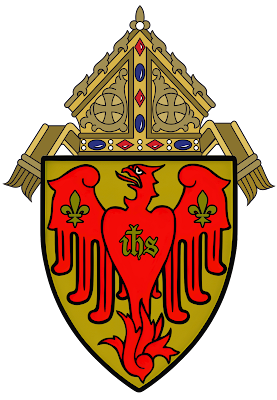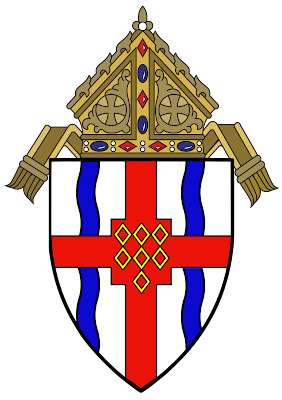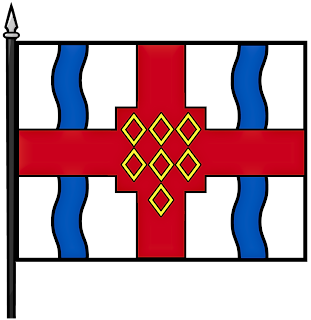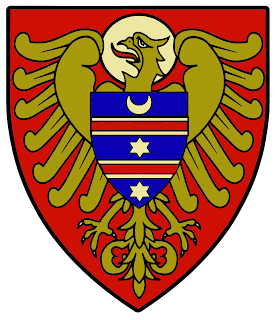.PNG) |
| The arms of Pierre de Chaignon la Rose as illustrated on his 1895 bookplate. Digital rendering by vErmines Love Supreme, August 2023. |
Herald/i/tis, noun: (i) a condition infecting an individual to employ heraldic decoration for artistic purposes without regards to the rules or customs of heraldry; (ii) when a designer of a coat arms ignores the primary canon, arma sunt distinguendi causa, that armorial bearings should simply and clearly identify its owner and nothing more.
Example: "The architect was deeply afflicted with heralditis and sketched out a new quartered coat of arms for the school's chapel, which does not clearly identify the school at all."
__________________
Acknowledgement
Special thanks and appreciation to Matthew Alderman, heraldic artist to the New England Historic Genealogical Society's Committee on Heraldry, for his gracious assistance in tracking down la Rose's article published in Liturgical Arts.
__________________
As the nation's leading herald in the early to mid-20th century, Pierre de Chaignon la Rose (1872-1941) encountered an American mindset afflicted with what he would eventually define as "heralditis." In nearly every new corporate coat of arms he would design for an organization, la Rose would spend more time sending correspondence to those leaders explaining the rules and customs of heraldry than any rationale for its design--a noble, yet exhausting endeavor.
There is no question, therefore, that la Rose's prescription for battling heralditis was pure and simple: education. La Rose was not the only herald on a mission to fight this good fight. Ralph Adams Cram (1863-1942) aided in the prescription of education with his article, "The Heraldry of the American Church" (1901 June 29). The Rev. Dr. C. Ellis Stevens (d. 1906) made an additional contribution to the cause with his 1902 article, "Anglican Episcopal Seals," (April 5, 431-435).
La Rose's first attempt can be found in a series of articles he published in Cram's Christian Art in 1907 (La Rose, 1907 May; La Rose, 1907, November). These two articles focus heavily on Anglican heraldry and specifically seals and arms found within the Episcopal Church. The singular focus is rather interesting, likely reflecting la Rose's growing impatience with appointed committees of amateurs.
In 1914, the herald would publish one last attempt to assuage fears of heralditis creeping into the Anglican and Episcopal Church with his article on ecclesiastical heraldry in The Living Church (La Rose, 1914 April 11, 835-836). Following publication in 1914, la Rose seemingly surrenders to the Episcopal Church; at present, there is no data concerning the herald's attempt to provide further education on heraldry within the Episcopal Church.
The fight against heralditis would be a life-long pursuit for the herald, engendering in many ways his life's purpose.
A recent discovery from the Archives of the University of Notre Dame revealed another such document promoting education of heraldry to fight the dreaded disease of heralditis. In an undated document written by la Rose, "Ecclesiastical Heraldry and Architects," we learn the herald's first use of heralditis (La Rose, n.d.). With the kind assistance from Matthew Alderman, we now know the undated document from the Archives of the University of Notre Dame was the basis for la Rose's article by the same name published by Liturgical Arts in 1933.
La Rose (1933) adds black and white emblazonments in the article of his designs for arms of the following archdioceses/dioceses: Cleveland, Monterey and Fresno, Manchester, Santa Fe, Portland (ME), Rochester, Milwaukee, Seattle, Helena, San Francisco, Toledo, and Leavenworth. The herald selected the Dioceses of Sacramento and Oklahoma for full colored emblazonments.
La Rose begins his manifesto:
"When the editor invited me to contribute an article on heraldry, I was a bit nonplussed, for heraldry is not a liturgical art, in that no phase whatever of the Church's liturgy involves its use. The Church existed for twelve centuries or more without the slightest need of it, and if tomorrow heraldry were to be wiped off the face of the globe--which I sometimes wish would happen--the Church would be no poorer liturgically.
"To phrase such a wish requires explanation. My reason for it is that, in America, the essential nature of heraldry and its underlying purpose are pretty generally misunderstood, and, in consequence, it is constantly misused, especially by architects, and, for our specific purpose in this article, in ecclesiastical fabrics" (La Rose, 1933, 187).
The article from 1933 gives us a glimpse into the herald's weary state of mind, having been worn down over the years by committees and armchair enthusiasts fighting back to advance heralditis in America.
 |
| The high altar at St. Vincent Ferrer Parish in New York City. Image is from the Parish's Facebook page. Click image to enlarge. |
Ever the teacher and educator, la Rose provides an example of heralditis for the readers of Liturgical Arts.
"Better to explain what I am driving at, let me cite one or two specific instances. In the church of Saint Vincent Ferrer, in New York, there is a frieze or band of decorative carving running round the clerestory which consists of an imposing array of coats-of-arms--an improbable decoration in a medieval church of its style.
"On my first visit there I studied these arms with interest, and I daresay I should have felt flattered, because a large number were coats which I had myself designed for their owners. But I could only groan, lamenting the, to me, obvious fact that my good friend, the architect, or some draughtsman in his office, had been temporarily afflicted with the worst case of 'heralditis' I have yet come across. For I could discover few if any of the shields to have logical reason for appearing there.
"To be specific, they were the arms of a number of Ordinaries, taken presumably from the Catholic Directory. Now, of the prelates represented, only one could possibly have had any kind of juridical relation to this particular church; none, so far as I remember them was a member of the Order of Preachers. I doubt if a single one had been a Benefactor, in the sense of having been financially concerned with the building of the fabric or its endowment; and finally, not one of them had yet been buried there.
"Why, then, string up the personal arms of a group of people, however distinguished, who had no relation to this building, to the clergy in charge of it, or to the congregation that worships there? This is sheer non-sensical heralditis, of a kind which no medieval architect would have ever been guilty" (La Rose, 1933, 190).
Indeed, why? The example from la Rose helps define this common illness which continues to plaque the American mindset to this very day. I should say that, although the herald made sweeping strides in his battle, the war on heralditis continues. Education for prevention is the best prescription, being mindful that this task can chip away at even the most battle-hardened knight.
Works Cited
Cram, R.A. (1901 June 29). The heraldry of the American church. The Churchman, 83(26), pp. 813-818.
La Rose, Pierre de C. (n.d.). Ecclesiastical heraldry and architects. Unpublished document.
Stevens, C.E. (1902 April 5). Anglican Episcopal seals. The Churchman, 85(14), pp. 431-435.
















.png)
.jpg)


.png)
.png)



.png)


.jpg)












.jpg)